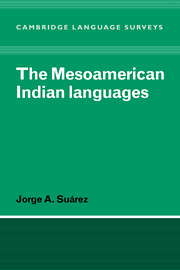Book contents
- Frontmatter
- Contents
- List of illustrations
- List of tables
- Preface
- Notational conventions
- Map 1 Present-day distribution of Mesoamerican Indian languages
- Table 1 Classification of Mesoamerican Indian languages and index to map 1
- 1 The study of Mesoamerican Indian languages
- 2 Dialects, languages and linguistic families
- 3 Phonology I
- 4 Phonology II
- 5 Morphology I
- 6 Morphology II
- 7 Syntax I
- 8 Syntax II
- 9 Preconquest literary traditions
- 10 The prehistory of Mesoamerican Indian languages
- 11 Indian languages after the conquest
- Appendix: Sources for sentences quoted in chapters 7 and 8
- References
- Language index
- Subject index
1 - The study of Mesoamerican Indian languages
Published online by Cambridge University Press: 05 November 2009
- Frontmatter
- Contents
- List of illustrations
- List of tables
- Preface
- Notational conventions
- Map 1 Present-day distribution of Mesoamerican Indian languages
- Table 1 Classification of Mesoamerican Indian languages and index to map 1
- 1 The study of Mesoamerican Indian languages
- 2 Dialects, languages and linguistic families
- 3 Phonology I
- 4 Phonology II
- 5 Morphology I
- 6 Morphology II
- 7 Syntax I
- 8 Syntax II
- 9 Preconquest literary traditions
- 10 The prehistory of Mesoamerican Indian languages
- 11 Indian languages after the conquest
- Appendix: Sources for sentences quoted in chapters 7 and 8
- References
- Language index
- Subject index
Summary
A glance at the chapter references in this book will show that most of the reference works were written within the last fifty years, and consequently any survey of the linguistic work done on the Mesoamerican Indian languages could not fail to stress the great improvement that works published within this period represent over previous studies. In any case, owing to obvious historical reasons, research on these languages does not go back more than four and a half centuries. In spite of this the study of Mesoamerican Indian languages has made a distinct contribution to our linguistic knowledge, and this chapter is devoted to giving an outline of its development.
The missionary period
Knowledge of Mesoamerican Indian languages began with the first Spaniards who had learned a native language and acted as interpreters, so that the beginnings of the study of these languages may be fixed arbitrarily from the time when, on 13 March 1519, the members of the expedition that would start the conquest of Mexico met Jerónimo de Aguilar, a survivor of a shipwreck who had lived among Mayan speakers and had learned their language. The Spaniards' earliest communication with the Indians was through interpreters and represented only a practical knowledge of the languages. The gathering of systematic knowledge proceeded basically along two lines: descriptions of the languages themselves and the gathering of general information about them.
- Type
- Chapter
- Information
- The Mesoamerican Indian Languages , pp. 1 - 10Publisher: Cambridge University PressPrint publication year: 1983



